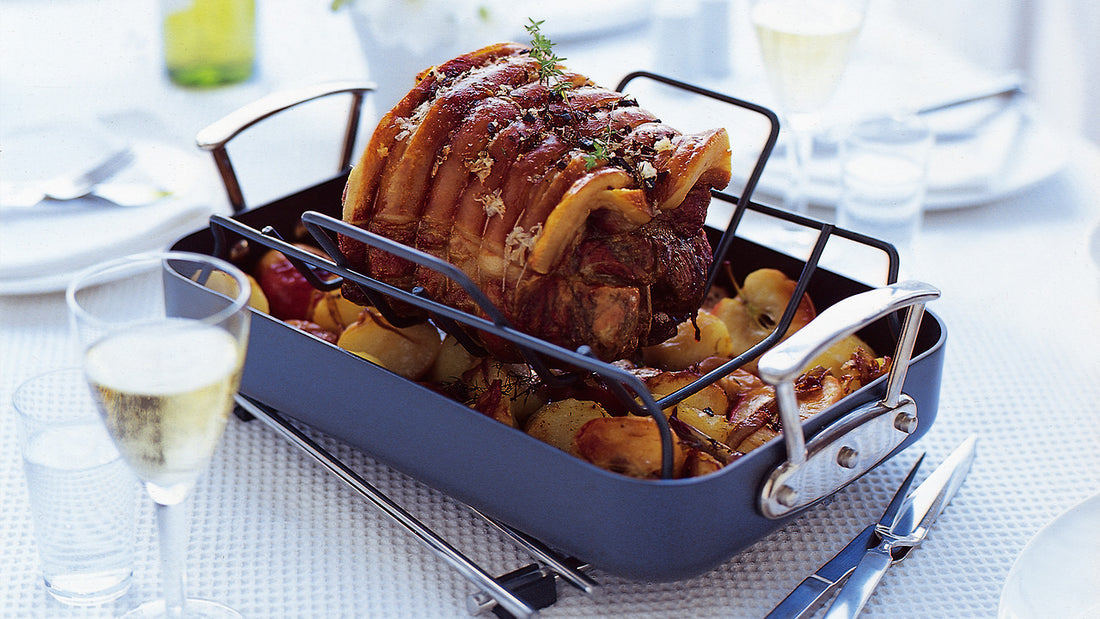If you are confused about choosing the right roasting pan,you came to the right place. It isinteresting to note that most home cooks only consider a roasting pan when oneis needed for the Christmas turkey or Sunday roast however, once you have agood quality one, you could use it for a lot more than just roasting at holidaytimes.
A roasting pan that is high quality will make your cookingexperience a better one so let us take you through the basics of what to lookfor when choosing a roaster.
What’s The Best Size?
The size of a roasting pan does matter. The food should beable to fit into the pan comfortably without being in contact with the sides.There should be enough space once the food is placed in to allow aircirculation, and so the underside turns brown.
Try not to use pans that are too large as this will make theingredients and meat juices burn because there is too much surface for thejuice to accumulate. You don’t want a thin layer of meat juices along the baseof the pan because it will burn easier, you want it to “pool up” a bit aroundthe meat. Of course if you add herbs or vegetables alongside the roast, thenyou may need a bigger pan.
How Deep Should It Be?
The height of the roasting pan is crucial as you really need it to be deep enough for a few reasons. The height should be sufficient when braising to avoid hot splashes or if you are using it as a water bath. Also, having too high sides on your roasting pan will cause the hot air to quickly rise and food will not be cooked evenly.
The side height should be deep enough so that vegetables like potatoes, carrots or pumpkin can be accommodated.
Ever roasted something and you’ve had a lot of smoke when you open the oven door? This is likely because the juices are splashing around and hitting the bottom of your oven! If you use a pan with sides that are high enough, this shouldn’t be an issue.
Shape is important too!
A rectangular pan shape is generally the most effective and popular one. Try to buy one that has its corners slightly rounded as it makes it easier to reach all the juices when making sauce or gravy.
Know Your Oven Size
Some of us succumb to impulsive buying and this includes buying a pan that is not appropriate for the size of the oven. There is nothing worse than bringing home a pan that doesn’t fit in the oven, so make sure you know the size of your oven before you buy.
The oven’s internal dimensions should be measured to ensure that then pan you buy fits properly. When you measure, make sure the width that you measure is the narrowest width.
The pan’s interior is the usual reference for these measurements you find on packaging, but the additional thickness of the walls of the pan makes a slight difference in the last measurement of the pan. While the thickness of the pan is usually minimal that is doesn’t matter, the design of the handles can actually increase the pans height and/or width.
Make Sure You Get a Hold On the Handle
Roasting pans also differs when it comes to handles. When it comes down to it, the design of the handles is a matter of preference. Some pans have handles that horizontally extend out from the pan’s sides that makes it easier in holding them however, these types of handles ultimately increase the overall size.
Heavy or Light?
A heavier roasting pan has some benefits over a lightweight pan however, both are suitable depending on your cooking needs. A lighter weight baking pan is great when just needing to cook a small piece of meat alone and don’t wish to cook your vegetables in the pan as well. A heavier pan is a better option when you are looking for a sizable pan which can not only accommodate the roast vegetables as well as the meat but you can also then move a heavier pan from the oven to the stove top to deglaze the pan and make a sauce or gravy from the juices.

